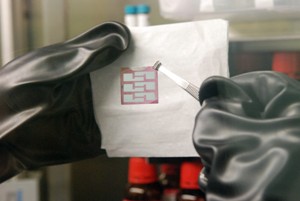Aug 22 2013
Work by a team of chemical engineers at Penn State and Rice University may lead to a new class of inexpensive organic solar cells.
 Work by a research team at Penn State and Rice University could lead to the development of flexible solar cells. The engineers' technique centers on control of the nanostructure and morphology to create organic solar cells made of block polymers. Image: Curtis Chan
Work by a research team at Penn State and Rice University could lead to the development of flexible solar cells. The engineers' technique centers on control of the nanostructure and morphology to create organic solar cells made of block polymers. Image: Curtis Chan
"Imagine if you could make solar cells as easily as you can print posters or newspapers -- you could make sheets of this," said Enrique Gomez, assistant professor of chemical engineering. "It represents a fundamental shift in the way in which we make solar cells."
Most solar cells today are inorganic and made of crystalline silicon. The problem with these, Gomez explained, is that inorganic solar cells tend to be expensive, rigid and relatively inefficient when it comes to converting sunlight into electricity.
But organic solar cells offer an intriguing alternative that's flexible and potentially less expensive.
Not many organic solar cells currently exist. He said, "There are a bunch of prototypes floating around. You see them in places like in solar-powered laptop bags and on the top of some bus depots."
The problem is that the bulk of organic solar cells employ fullerene acceptors -- a carbon-based molecule that's extremely difficult to scale up for mass production.
Gomez's approach skips the fullerene acceptor altogether and seeks to combine molecules in a solution.
The idea of utilizing molecular self-assembly for solar cells isn't new, but Gomez said, "It's not been well executed."
He continued, "It's like trying to mix oil and water." The issue is that weak intermolecular interactions and disorder at junctions of different organic materials limited the performance and stability of previous organic solar cells.
But by controlling the nanostructure and morphology, the team essentially redesigned the molecules to link together in a better way.
The engineers were able to control the donor-acceptor heterojunctions through microphase-separated conjugated block copolymers.
"We have not only demonstrated control of the microstructure, but also control of the interface responsible for the initial steps in charge photogeneration in a way never achieved before," Gomez said.
The result, which was detailed in a recent issue of the American Chemical Society's Nano Letters journal, is an organic solar cell made of block copolymers that's three percent efficient.
The team included Penn State chemical engineering graduate student Changhe Guo; undergraduate student Matt Witman; Rafael Verduzco, the Louis Owen Assistant Professor of Chemical and Biomolecular Engineering at Rice University; Joseph Strzalka, research scientist at Argonne National Laboratory; and research scientists Cheng Wang and Alexander Hexemer of Lawrence Berkeley National Laboratory.
Though the team's prototype is not as efficient as some solar cells that are commercially available, Gomez explained the work shows flexible organic solar cells are indeed possible.
"Our cells right now don't capture a lot of light. We need to look back and redesign the molecule. We think we can do better than 3 percent," he said.
A video of the work may be accessed on Penn State's YouTube site at https://www.youtube.com/watch?v=KC1iJ_tAS58&list=PL688BFA62C747F6EB.